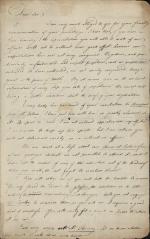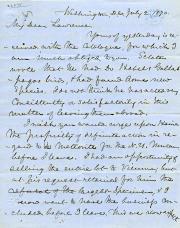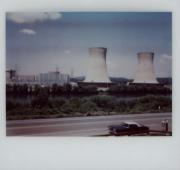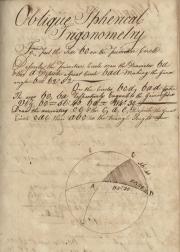Letter from Joseph Priestley to Charles Blagden

Scientist, clergyman, and scholar Joseph Priestley writes to Dr. Charles Brian Blagden, asking for an insertion to his paper that was read to the Lunar Society.


Scientist, clergyman, and scholar Joseph Priestley writes to Dr. Charles Brian Blagden, asking for an insertion to his paper that was read to the Lunar Society.

Dr. Joseph Priestley writes to Dr. Benjamin Smith Barton regarding Antiphlogistion enemies, a yellow fever outbreak, and scientist Dr. John Maclean.

Joseph Priestley writes to John Seddon regarding Seddon's invitation to Liverpool, recent books, work, and news regarding lectures at the Academy. Transcript included.

Spencer Fullerton Baird (1823-1887) was a Dickinson College graduate (class of 1840) and a professor of natural history and science at the college from 1845 until 1850, when he became assistant secretary of the Smithsonian Institute (1850-1878). He was later promoted to secretary of that institution in 1878 and remained in that capacity until his death. The collection consists solely of correspondence between Spencer Fullerton Baird and his friend and colleague George Newbold Lawrence between 1868 and 1873. The bulk of the correspondence is from Baird to Lawrence, with a few drafts of letters from Lawrence to Baird.

This collection consists of drafts, letters, manuscripts, notes, financial accounts, and a prospectus for the publication of a book. Specifically, there are lectures and notes on mechanics, as well as drafts for patents on inventions submitted to the Royal Commissioners of the Great Exhibition of 1850, including an air engine. The collection also includes letters and papers on W. L. Henson's Knitting Machine, plans and contracts for the establishment of railways and public works in India, and photographs of the "New" Lebaudy Airship and Airship Hanger.

The Edwin K. Charles collection consists of the various papers, government documents, newsletters, transcripts, and publications collected by Charles in the years following the accident at Three Mile Island. Edwin K. Charles, a resident of Mechanicsburg, Pennsylvania, became heavily involved with the public-awareness group, Three Mile Island Alert, directly following the accident at Three Mile Island in 1979. Over the years, he collected various materials concerning the legal struggles between the NRC, GPU, and Three Mile Island Alert.

The Bevery Hess collection consists of the various papers, newspaper clippings, books, audiotapes and photographs collected by Hess during her most active period of involvement with local anti-nuclear groups. Bevery Hess was a resident of Lancaster County, Pennsylvania prior to the accident at Three Mile Island, Unit 2. After the accident, Beverly Hess became heavily involved in the local anti-nuclear movement. She was a founding member of the Susquehanna Valley Alliance and the Public Interest Resource Center (PIRC). An appendix is included, which lists the books belonging to the Beverly Hess collection.

This collection primarily provides evidence of the personal and professional life of Charles Francis Himes, student, photographer, scientist, teacher, administrator, amateur historian and father. Also found in this collection is evidence of the lives of family members including, most notably, C. F. Himes' wife Mary and her father Joseph A. Murray. Information on Dickinson College is featured prominently throughout this collection through the close association of C. F. Himes with the institution during most of his life. Beyond family and institutional history, this collection offers information on a number of social, political, economic, and historic topics. Some of these broader topics include post-secondary education in the latter half of the nineteenth century, south central Pennsylvania society, the history of photography, and nineteenth century travel.

This collection primarily provides evidence of the personal and public life of Frank E. Masland Jr., environmentalist, preservationist, explorer, entrepreneur, author, and community leader. Also found in this collection is correspondence from prominent twentieth-century figures such as leaders of the National Park Service, journalists, politicians throughout the world, and American presidents. Information on Dickinson College is featured prominently throughout this collection through the close association of Masland with the institution during most of his life. This collection offers information on a number of social, political, economic, and historic topics through the eyes of a man who witnessed nearly the entire twentieth century. Some of these broader topics include the industrialization of the United States, south central Pennsylvania community, the rise of environmentalism, reactions to communism, the rise of the New Left, and twentieth-century exploration. The processing of this collection was made possible by a grant from the Pennsylvania Historical and Museum Commission.

The Fred Loomis Mohler collection contains articles written by Mohler and his colleagues that reflect their scientific research. The Writings-Mohler series consists of articles written by Fred Loomis Mohler. These documents focus on his discoveries, specifically in atomic physics, mass spectra of specific elements such as nitrogen, photoionization, recombination of ions, and cesium vapor. The Writings-Associates series contains scientific journal articles published by Mohler's colleagues and mentors. Many of these articles pertain to studies Mohler himself was performing, such as Boeckner's experimentation with cesium.

The John H. Murdoch collection consists of various papers, newspaper clippings, audiotapes, and photographs collected by Murdoch during his involvement with Three Mile Island Alert. John Murdoch was a long-time resident of Lower Allen Township, Cumberland County and became involved in emergency communications and the activities of Three Mile Island Alert, the public-awareness group, following the accident at Three Mile Island on March 28, 1979. Throughout the decade after the accident, Murdoch devoted much of his time and energy to the fight against the restart of Three Mile Island.

These images were taken from a number of books housed in the Dickinson College Archives and Special Collections.
The sources include:
Thomas Pennant's History of Quadrupeds. Vols. 1 and 2 (1793)
William P. C. Barton's Vegetable Materia Medica of the United States or Medical Botany. Vols. 1 and 2 (1825)
Sir William Jardine's The Natural History of Monkeys (1833)
M. C. Cooke's Our Reptiles: A Plain and Easy Account of the Lizards, Snakes, Newts, Toads, Frogs, and Tortoises Indigenous to Great Britain (1865)
W. B. Tegetmeier's Pigeons: Their Structure, Varieties, Habits, and Management (1868)
Joseph B. Holder's Animate Creation; Popular Edition of “Our Living World,” A Natural History. Vols. 1 - 6 (1898)
J. Delarue's Galerie des Mammiferes. (18??)

The Priestley Award was established by Dickinson College in honor and memory of Joseph Priestley, the eighteenth century scientist and theologian best known as the discoverer of oxygen. Every year the award is presented to a distinguished scientist for his or her discoveries or contributions to the welfare of mankind.
The Priestley Award collection is organized chronologically by the year in which the award was presented. Also included in this collection is some biographical information on Joseph Priestley, general information about the award itself, a history of the award written by Horace Rogers, financial receipts, and information on the 1973 Science for Survival Symposium.
Each yearly award celebration series is further divided into different folders. These divisions include folders for correspondence; event preparation; posters, programs, and invitations; news releases and publications; and nominating committee. Correspondence consists of letters concerning the award and celebration, inter-office memos, and invitations, all arranged chronologically. The event preparation file consists of various papers such as invitation lists, menus, sample letters, itineraries, speech transcriptions, and any other information collected by the President of the College in preparation for that year’s award. The posters, programs, and invitations folders contain ephemeral materials related to the annual event. In the news releases and publications file, all newspaper articles and other writings pertaining to the award or the award winner are maintained. Nominations, ballots, and letters and memos concerning the nominations can be found in the nominating committee file.

This collection includes letters, documents, clippings, pamphlets, and photographs relating to Joseph Priestley and his descendants. It was presented to the college by Mrs. Temple Fay.

This collection includes articles, manuscripts, newspaper clippings, and programs about Joseph Priestley and related topics. Also included in the collection are genealogical materials - correspondence, notes, charts - collected by Priestley family members

The Charles Arthur Robinson Collection was donated by Charles L. Robinson on January 14, 2012. The collection is housed in two document boxes, one oversized box, 57 photograph folders, and one small artifact box. The collection contains materials related to Charles A. Robinson ('20) and Reba M. Beam’s ('22) Dickinson College careers as well as their married life. It also includes items belonging to Dickinson graduates Harry Delmar Robinson ('18) and Dorothy Anne Robinson ('45). The Collection is arranged into eight series: Academic Papers, Correspondence, Ephemera, Financial Papers, Photograph Albums, Miscellaneous, Oversized, Photographs, and Artifact.

Wilbur Morris Stine (1863-1934) graduated with Dickinson College's class of 1886 and later received advanced degrees from both Dickinson College and Ohio University. He served on the engineering faculty at Ohio University, the Armour Institute of Technology, and Swarthmore College. Stine also received national recognition for his research with x-rays. These papers include documents dealing with his 1891 battery patent application and clippings of articles written by Stine on electricity, x-rays, and science education. The collection also includes some correspondence pertaining to Stine's short involvement with the Swarthmore College Press, as well as 30 literary notebooks containing typescripts of essays, poems, speeches, and stories written by Stine.

Thomas W. Troxell (1874-1947) graduated from Dickinson College in 1898. He taught at schools in North Carolina, Maryland, Virginia, and West Virginia before finishing his career as principal at Gaithersburg High School in Maryland. This small collection contains materials related to Troxell’s time at Dickinson, specifically several student notebooks, and his career as a teacher.

The Anthony Wayne collection consists of four notebooks kept by Anthony, Charles, and Isaac Wayne. The two notebooks belonging to Anthony Wayne, dated 1762 to 1764, contain notes on mathematics and surveying; the notebook of Charles Wayne also includes notes on mathematics. Isaac Wayne's notebook includes his financial accounts as well as brief journal entries of his activities. Some loose notes are also among Isaac's papers.